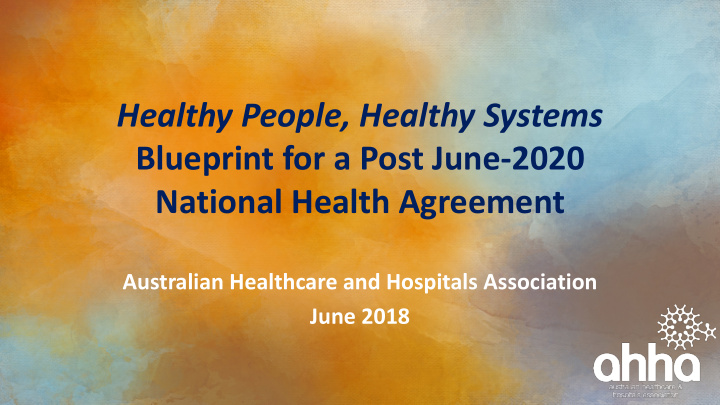



Healthy People, Healthy Systems Blueprint for a Post June-2020 National Health Agreement Australian Healthcare and Hospitals Association June 2018
Blueprint development context • Invited by Minister Greg Hunt to contribute ideas for a 10 year blueprint to reform the health system – Also invited by Bill Shorten and Catherine King • Substantial consultation with, and input from: – AHHA Board and membership – Stakeholders--hospital, primary and community health sectors – Clinicians, academics, policymakers, administrators and consumers. • Backed with Case Studies submitted by stakeholders – Aligned to each of four domains for reform – Exemplars of success already being achieved
Healthcare system context • April 2016 agreement between the Commonwealth, state and territory governments for funding public hospitals ends 30 June 2020 • Recognition of the need for more integrated healthcare services • Changing population characteristics, needs and expectations • Health system funding pressures: – Commonwealth – States and territories – Non-government sources (esp. out-of-pocket)
A 10-year strategic vision • Reorientate the health system to be: – Patient-centred – Outcomes-focused – Value-based • A series of practical steps to progressively move the health system towards achieving these goals: – In the short term – over 2 years – In the medium term – over 5 years – In the long term – over 7 to 10 years
Value-based healthcare • Value-based health care in the sense defined by Porter: Health outcomes achieved Value = Cost of achieving these outcomes
Four key domains for strategic reform 1. Governance— nationally unified, regionally controlled 2. Data— fit-for-purpose performance information and reporting 3. Workforce— serve and meet population health needs 4. Funding— sustainable and appropriate for high quality
Case studies 15 case studies published on www.ahha.asn.au Demonstrate outcomes-focused and value-based healthcare Cover each of the four domains Four case studies selected for today: Governance—Alpine Health adolescent suicide prevention (Vic) Data—Performance information and reporting (NSW) Workforce—Allied Health Rural Generalist Pathway (Qld) Funding—Community dental clinic for homeless youth (Qld)
Key recommendations for governance 1. Independent national health authority reporting to COAG Covers primary care, dental care, hospital pricing, National Health Funding Pool, AIHW, ADHA, ACSQHC Single source of truth for national health data collection (performance and funding) and regular reporting 2. Formalised agreements with PHNs (Cwlth) and LHNs (S/T)-- for consistent regional governance--needs assessments, priority setting, funding, coordination, reducing hospital admissions/presentations
Case study--Alpine Health adolescent suicide prevention • Community anxiety about risk of adolescent suicide in the region. • Alpine Health governance arrangements and community engagement enabled pooled funding and set-up of a governing board to operate three services in partnership: – Rural adolescent health program, youth advocacy and support, and health promotion (positive behaviour and lifestyle) – Supported by families, police, GPs – Next step: involve local schools • No suicides for over 15 years
Key recommendations for data 1. All providers receiving government funding required to supply patient outcomes/service dimensions data. 2. National data system for primary healthcare. 3. Patient-reported experience and outcome measures. 4. Interoperability standards for data sharing. 5. National approach to measuring value-based patient-centred outcomes. 6. Regional needs assessments to drive investment in prevention
Case study—Perf. info & reporting NSW • Driven by NSW Agency for Clinical Innovation • Patient Reported Measures (PRMs)—outcomes and experience--implemented in range of settings already • Captures, via iPads, in real time, patient voice at individual, service and system level • Outcome reports available in real time, experience reports available monthly • Complements patient survey work undertaken by other NSW Govt organisations
Key recommendations for workforce 1. Develop a National Health Workforce Reform Strategy. 2. Goes beyond what is happening now. 3. Pursues outcomes-focused and value-based changes in scope of practice and models of care to meet public needs. 4. Coordinate with education, regulation and funding considerations at all levels and across health service environments.
Case study—Allied Health Rural Generalist Pathway • First established 2014 (Qld). • Pathway integrates 7 allied health professions in: – delivering services and strategies that reflect local needs – providing rural generalist training position opportunities with training supports and expectations – formal university education programs—rural generalists in each profession—skills, advanced practice, extended scope of practice and clinical task-sharing. • Optimises outcomes for complex and chronic conditions .
Key recommendations for funding 1. Current Cwlth public hospital funding levels and growth formula maintained for 7 years. 2. Health services funded regionally--agreements centred on patient needs, also attractive to providers. 3. Financial incentives for standardised tracking of patient outcomes 4. Funding formula includes 25% component for achieved health outcomes across agreed top 4 diseases/conditions/risk factors/determinants 5. Dedicated funds for prevention activities.
Case study--Community dental clinic, homeless youth • Integrates dental care with Brisbane Youth Service care programs-- volunteer oral health professionals in cooperation with UQ. • Four clinics a year, one week at a time. • Highlights value of increasing access to oral health care for those least likely to use it--homeless youth. • Relies on volunteer services--but no shortage of volunteers. • Demonstrates the value of oral health care provided within a holistic approach to preventive healthcare activities, improving funding sustainability in the longer term.
Sharing Blueprint and case studies well-received at national, state and territory levels by: • Health ministers (regardless of party affiliation) • Senior departmental staff • Health sector thought leaders.
Conclusion Health people, healthy systems , is a feasible plan, the only one so far, aimed at moving the Australian healthcare system towards better meeting current and future patients needs while remaining sustainable and of the highest quality.
‘Nobody knew healthcare could be so complicated’ Donald Trump
Thank you ahha.asn.au/blueprint
Recommend
More recommend